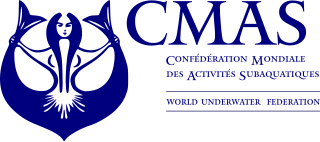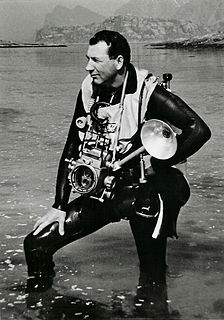Related Research Articles
Nitrox refers to any gas mixture composed of nitrogen and oxygen. This includes atmospheric air, which is approximately 78% nitrogen, 21% oxygen, and 1% other gases, primarily argon. In the usual application, underwater diving, nitrox is normally distinguished from air and handled differently. The most common use of nitrox mixtures containing oxygen in higher proportions than atmospheric air is in scuba diving, where the reduced partial pressure of nitrogen is advantageous in reducing nitrogen uptake in the body's tissues, thereby extending the practicable underwater dive time by reducing the decompression requirement, or reducing the risk of decompression sickness.

Trimix is a breathing gas consisting of oxygen, helium and nitrogen and is used in deep commercial diving, during the deep phase of dives carried out using technical diving techniques, and in advanced recreational diving.

Technical diving is scuba diving that exceeds the agency-specified limits of recreational diving for non-professional purposes. Technical diving may expose the diver to hazards beyond those normally associated with recreational diving, and to a greater risk of serious injury or death. The risk may be reduced by appropriate skills, knowledge and experience, and by using suitable equipment and procedures. The skills may be developed through appropriate specialised training and experience. The equipment often involves breathing gases other than air or standard nitrox mixtures, and multiple gas sources.

Recreational diver training is the process of developing knowledge and understanding of the basic principles, and the skills and procedures for the use of scuba equipment so that the diver is able to dive for recreational purposes with acceptable risk using the type of equipment and in similar conditions to those experienced during training.

Gas blending for scuba diving is the filling of diving cylinders with non-air breathing gases such as nitrox, trimix and heliox. Use of these gases is generally intended to improve overall safety of the planned dive, by reducing the risk of decompression sickness and/or nitrogen narcosis, and may improve ease of breathing.

Scuba diving is a mode of underwater diving whereby divers use breathing equipment that is completely independent of a surface air supply. The name "scuba", an acronym for "Self-Contained Underwater Breathing Apparatus", was coined by Christian J. Lambertsen in a patent submitted in 1952. Scuba divers carry their own source of breathing gas, usually compressed air, affording them greater independence and movement than surface-supplied divers, and more time underwater than free divers. Although the use of compressed air is common, a gas blend with a higher oxygen content, known as enriched air or nitrox, has become popular due to the reduced nitrogen intake during long and/or repetitive dives. Also, breathing gas diluted with helium may be used to reduce the likelihood and effects of nitrogen narcosis during deeper dives.
Scuba Schools International (SSI) is an organization that teaches the skills involved in scuba diving and freediving, and supports dive businesses and resorts. SSI has over 2,500 authorized dealers, 35 regional centers, and offices all over the world.
Technical Diving International (TDI) claims to be the largest technical diving certification agency in the world, and one of the first agencies to offer mixed gas and rebreather training. TDI specializes in more advanced Scuba diving techniques, particularly diving with rebreathers and use of breathing gases such as trimix and heliox.

The Federazione Italiana Attività Subacquee (FIAS) is an Italian non-profit diver training organization. It is a member of:
Master Scuba Diver (MSD) is a scuba diving certification or recognition level offered by several North American diver training agencies, such as the National Association of Underwater Instructors (NAUI), the Professional Association of Diving Instructors (PADI), Scuba Diving International (SDI), and Scuba Schools International (SSI). Other agencies offer similar programs under other names, such as "Elite Diver". Each of these agencies touts their program at this level as the highest, non-leadership program.

Richard Rutkowski is a pioneer in the fields of hyperbaric medicine, diving medicine and diver training, especially in relation to the use of breathing gases.
"Captain" Billy Deans is a pioneering wreck and technical diver. "Captain" is the nickname which is widely applied to Billy Deans, however he is a US Coast Guard-rated captain up to 100 tons.
Steve Lewis is an active cave and wreck diver. Born in Peckham, New Cross London, he currently resides in Muskoka, Ontario Canada.

Confédération Mondiale des Activités Subaquatiques (CMAS) is an international federation that represents underwater activities in underwater sport and underwater sciences, and oversees an international system of recreational snorkel and scuba diver training and recognition. It is also known by its English name, the World Underwater Federation, and its Spanish name, Confederación Mundial De Actividades Subacuáticas. Its foundation in Monaco during January 1959 makes it one of the world's oldest underwater diving organisations.

Bret Clifton Gilliam is a pioneering technical diver. He is most famous as the founder of the certification agency Technical Diving International, and as the one time holder of the world record for deep diving on air. He is also one of diving's most popular writers. Gilliam is the author or coauthor of 72 books, over 1500 feature magazine articles, and over 100 magazine cover photos. In his diving career he has logged over 19,000 dives since 1959.
The Fédération Française d'Études et de Sports Sous-Marins (FFESSM) is a French sports federation specialized in recreational and competition underwater sports, like scuba diving and freediving. It is the main diver training organization in France.
The Association nationale des moniteurs de plongée is a French professional body recognized by the Ministry of Sports. It is empowered to grant certification to recreational divers in France.

The history of scuba diving is closely linked with the history of equipment. By the turn of the twentieth century, two basic architectures for underwater breathing apparatus had been pioneered; open-circuit surface supplied equipment where the diver's exhaled gas is vented directly into the water, and closed-circuit breathing apparatus where the diver's carbon dioxide is filtered from the exhaled breathing gas, which is then recirculated, and more gas added to replenish the oxygen content. Closed circuit equipment was more easily adapted to scuba in the absence of reliable, portable, and economical high pressure gas storage vessels. By the mid-twentieth century, high pressure cylinders were available and two systems for scuba had emerged: open-circuit scuba where the diver's exhaled breath is vented directly into the water, and closed-circuit scuba where the carbon dioxide is removed from the diver's exhaled breath which has oxygen added and is recirculated. Oxygen rebreathers are severely depth limited due to oxygen toxicity risk, which increases with depth, and the available systems for mixed gas rebreathers were fairly bulky and designed for use with diving helmets. The first commercially practical scuba rebreather was designed and built by the diving engineer Henry Fleuss in 1878, while working for Siebe Gorman in London. His self contained breathing apparatus consisted of a rubber mask connected to a breathing bag, with an estimated 50–60% oxygen supplied from a copper tank and carbon dioxide scrubbed by passing it through a bundle of rope yarn soaked in a solution of caustic potash. During the 1930s and all through World War II, the British, Italians and Germans developed and extensively used oxygen rebreathers to equip the first frogmen. In the U.S. Major Christian J. Lambertsen invented a free-swimming oxygen rebreather. In 1952 he patented a modification of his apparatus, this time named SCUBA, an acronym for "self-contained underwater breathing apparatus," which became the generic English word for autonomous breathing equipment for diving, and later for the activity using the equipment. After World War II, military frogmen continued to use rebreathers since they do not make bubbles which would give away the presence of the divers. The high percentage of oxygen used by these early rebreather systems limited the depth at which they could be used due to the risk of convulsions caused by acute oxygen toxicity.
Recreational scuba certification levels are the levels of skill represented by recreational scuba certification. Each certification level is associated with a specific training standard published by the certification agency, and a training programme associated with the standard., though in some cases recognition of prior learning can apply. These levels of skill can be categorised in several ways:
ProTec - Professional Technical and Recreational Diving is an international dive training agency based in Munich, Germany.